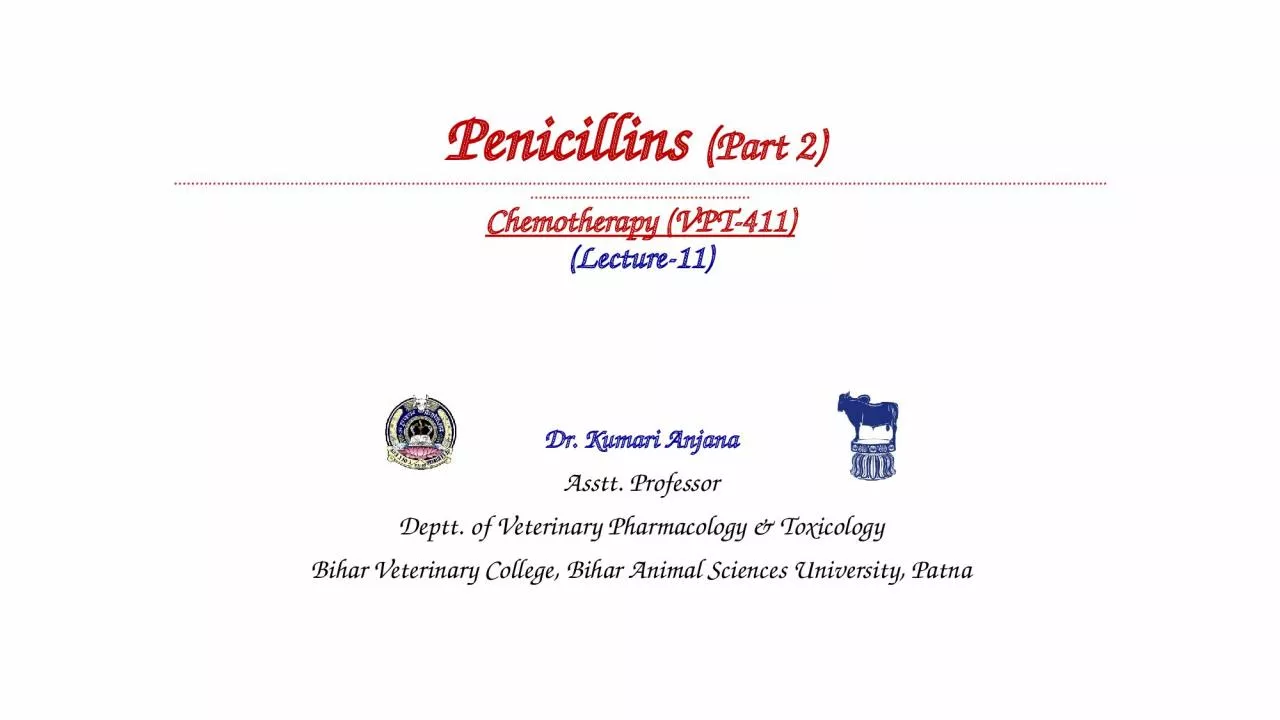/


Download Presentation The PPT/PDF document "Penicillins ( Part 2)" is the property of its rightful owner. Permission is granted to download and print the materials on this web site for personal, non-commercial use only, and to display it on your personal computer provided you do not modify the materials and that you retain all copyright notices contained in the materials. By downloading content from our website, you accept the terms of this agreement.
1. Penicillins (Part 2) ……………………………………………………………………………………………………………………………………………………………………………………………………………………………………………Chemotherapy (VPT-411)(Lecture-11)Dr. Kumari AnjanaAsstt. ProfessorDeptt. of Veterinary Pharmacology & ToxicologyBihar Veterinary College, Bihar Animal Sciences University, Patna
2. Content of the chapterPenicillins – Pharmacokinetics Clinical Uses of Penicillins Administration and Dosages of Penicillins Adverse Reactions and Toxicity of Penicillin Beta-lactamases Beta-lactamase inhibitors Potentiated Penicillins
3. PharmacokineticsPenicillin G, its salts and methicillin are destroyed by gastric acid and are orally ineffective. Only the acid resistant Penicillins can be given orally and their peak plasma concentration is reached within about two hours. Most of the Penicillins including repository Penicillins are administered parenterally (usually IM).Penicillins are widely distributed in the body fluid and tissue.
4. Clinical Uses of Penicillins The penicillins are used in the treatment of local and systemic infections caused by the sensitive bacteria. Penicillin G is of value in the treatment of Bovine mastitis (primarily in streptococcal mastitis),Anthrax, Erysipelothrix infection in sheep, pigs and birds.Strangles in horses, Clostridial infections (tetanus and black quarter),Pyelonephritis and lumpy jaw in cattle, Beta-haemolytic streptococcal infection in puppies, Meningococcal meningitis and Leptospirosis.
5. Administration and Dosages of PenicillinsThe dosage of penicillin G is usually expressed as units. One standard unit of penicillin is defined as the amount of antibacterial activity present in 0.6 µgm of pure crystalline standard sodium penicillin G (1 mg – 1667 Oxford units). The dosage of semisynthetic penicillins is expressed in mg/kg.
6. Sodium penicillin G -- 10,000-20,000 IU/kg, IM or IV repeated after 6 hr. intervalBenzathine penicillin G -10,000-40,000 IU/kg IM in horse and SC in cattle repeated after 48-72 hr.Penicillin-V— 15000 IU/kg oral repeated at 8 hr. intervals.Amoxicillin-- 4-8 mg/kg IM repeated after 12-24 hr. interval. 12 mg/kg oral repeated after 12 hr. interval.Carbenicillin-10-20 mg/kg IV or IM repeated after 8- 12 hr. interval.Cloxacillin-- 10 mg/kg IM or oral repeated after 12 hr. interval.
7. Procaine penicillin G – 25,000 IU/kg, oral repeated after 6 hr. interval10,000-30,000 IU/kg IM or SC repeated after 12-24 hr. interval.Source : Google image
8. Ampicillin – 5-10 mg/kg IV, IM or SC repeated after 6 hr. interval.10- 25 mg/kg oral repeated after 6 -12 hr. interval.Source : Google image
9. Repository PenicillinsBenzathine penicilline G and procaine penicillin G in oil. These are the penicillins which are slowly absorbed over a period of 5-7 days following a single IM injection. Probenecid was developed as an alternative to caronamide to competitively inhibit renal excretion of some drugs, thereby increasing their plasma concentration and prolonging their effects.Probenecid delays renal excretion of penicillins and prolongs the blood levels of penicillins with short plasma half-life. It is added @ 1-2 mg/1000IU of penicillin G for oral dosing in dog at 6 hr. intervals. The repository forms of penicillin should never be injected IV.
10. Adverse Reactions and Toxicity of PenicillinHypersensitive, allergic or anaphylactic reactions (mostly along with streptomycin) are reported in dog, cattle and horse following prior sensitization to the antibiotic. GI disturbancesPlatelet dysfunctionOrgan toxicityCation Toxicity
11. Beta-lactamasesBeta-lactamases are enzymes produced by penicillin-resistant bacteria, which break the antibiotic into inactive penicilloic acid. They are named as beta-lactamases as they act by splitting the beta-lactam ring present in beta-lactam antibiotics, penicillins and cephalosporins.The enzyme is of two types: Penicillinase and Cephalosporinase.
12. Beta-lactamase inhibitorsBeta-lactamase inhibitors: These potentiate or reestablish the antibacterial potency penicillinase sensitive penicillins.It is active against beta-lactamase producing organisms by inhibition of the enzyme (suicidal inhibition). These inhibitors are structurally similar to penicillin and act as substitutes for penicillinase (B-lactamase) causing inhibition of the enzyme.
13. Clavulanic acid: Obtained from Streptomyces clavuligerus, has no antibacterial activity of its own. It is generally combined with amoxicillin (Augmentin) or ticarcillin (Timentin). Sulbactam: A semisynthetic beta-lactamase inhibitor, related chemically and in activity to clavulanic acid. It is combined with ampicllin and preferably for oral and parenteral administration. Tazobactam: It is similar to sulbactam and combined with piperacillin.
14. Potentiated PenicillinsPotentiated Penicillins: Penicillins + β-lactamase inhibitors = Potentiated PenicillinsThe combinations are: Amoxicillin-Clavulanic acid (4:1),Ticarcillin-clavulanic acid- (15:1) andAmpicillin-sulbactam. Dose: Potassium clavulanate: amoxicillin (1:4) @ 10-20 mg/kg (amoxicillin) and ;2.5-5 mg/kg (clavulanate) orally at 12 hr. Penicillins with sulbactam and tazobactum are administered IV; with clavulanic acid are administered orally or IV.
15. Summary(1 mg – 1667 Oxford units). Beta-lactamase inhibitors: These potentiate or reestablish the antibacterial potency penicillinase sensitive penicillins.Potentiated Penicillins: Penicillins + β-lactamase inhibitors = Potentiated Penicillins
16. Thank You